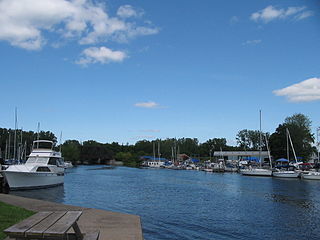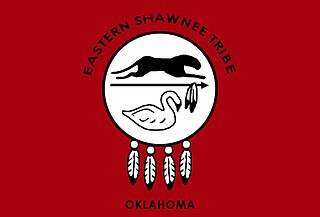
The Erie Canal is a canal in New York, United States that is part of the east–west, cross-state route of the New York State Canal System. Originally, it ran 363 miles (584 km) from the Hudson River in Albany to Lake Erie in Buffalo. It was built to create a navigable water route from New York City and the Atlantic Ocean to the Great Lakes. When completed in 1825, it was the second longest canal in the world and greatly enhanced the development and economy of New York, New York City, and the United States.

The Finger Lakes are a group of eleven long, narrow, roughly north–south lakes in an area informally called the Finger Lakes region in New York, in the United States. This region straddles the northern and transitional edge, known as the Finger Lakes Uplands and Gorges ecoregion, of the Northern Allegheny Plateau and the Ontario Lowlands ecoregion of the Great Lakes Lowlands.

Seneca Lake is the largest of the glacial Finger Lakes of the U.S. state of New York, and the deepest lake entirely within the state. It is promoted as being the lake trout capital of the world, and is host of the National Lake Trout Derby. Because of its depth and relative ease of access, the US Navy uses Seneca Lake to perform test and evaluation of equipment ranging from single element transducers to complex sonar arrays and systems. The lake takes its name from the Seneca nation of Native Americans. At the north end of Seneca Lake is the city of Geneva, New York, home of Hobart and William Smith Colleges and the New York State Agricultural Experiment Station, a division of Cornell University. At the south end of the lake is the village of Watkins Glen, New York, famed for auto racing and waterfalls.

The Allegheny River is a 325-mile (523 km) long headwater stream of the Ohio River in western Pennsylvania and New York, United States. The Allegheny River runs from its headwaters just below the middle of Pennsylvania's northern border northwesterly into New York then in a zigzag southwesterly across the border and through Western Pennsylvania to join the Monongahela River at the Forks of the Ohio on the "Point" of Point State Park in Downtown Pittsburgh, Pennsylvania. The Allegheny River is, by volume, the main headstream of both the Ohio and Mississippi Rivers. Historically, the Allegheny was considered to be the upper Ohio River by both Native Americans and European settlers.

Seneca County is a county located in the U.S. state of New York. As of the 2010 census, the population was 35,251. The primary county seat is Waterloo, moved there from the original county seat of Ovid in 1819. It became a two-shire county in 1822, which currently remains in effect, using both locations as county seats although the majority of Seneca County administrative offices are located in Waterloo. Therefore, most political sources only list Waterloo as the county seat. The county's name is from the Iroquois (Seneca) that occupied part of the region.

Seneca County is a county located in the northwestern part of the U.S. state of Ohio. As of the 2010 census, the population was 56,745. Its county seat is Tiffin. The county was created in 1820 and organized in 1824. It is named for the Seneca Indians, the westernmost nation of the Iroquois Confederacy, which was based in present-day New York but had territory into Pennsylvania and Ohio.

Geneva is a city in Ontario and Seneca counties in the U.S. state of New York. It is at the northern end of Seneca Lake; all land portions of the city are within Ontario County; the water portions are in Seneca County. The population was 13,261 at the 2010 census. The city is supposedly named after the city and canton of Geneva in Switzerland. The main settlement of the Seneca was spelled Zoneshio by early white settlers, and was described as being 2 miles north of Seneca Lake.

Seneca Falls is a town in Seneca County, New York, United States. The population was 9,040 at the 2010 census.
The Seneca are a group of indigenous Iroquoian-speaking people native to North America who historically lived south of Lake Ontario. They were the nation located farthest to the west within the Six Nations or Iroquois League (Haudenosaunee) in New York before the American Revolution.

Watkins Glen State Park is in the village of Watkins Glen, south of Seneca Lake in Schuyler County in New York's Finger Lakes region. The park's lower part is near the village, while the upper part is open woodland. It was opened to the public in 1863 and was privately run as a tourist resort until 1906, when it was purchased by New York State. Initially known as Watkins Glen State Reservation, the park was first managed by the American Scenic and Historic Preservation Society before being turned over to full state control in 1911. Since 1924, it has been managed by the Finger Lakes Region of the New York State Office of Parks, Recreation and Historic Preservation.
The Cayuga was one of the five original constituents of the Haudenosaunee (Iroquois), a confederacy of Native Americans in New York. The Cayuga homeland lies in the Finger Lakes region along Cayuga Lake, between their league neighbors, the Onondaga to the east and the Seneca to the west. Today Cayuga people belong to the Six Nations of the Grand River First Nation in Ontario, and the federally recognized Cayuga Nation of New York and the Seneca-Cayuga Tribe of Oklahoma.

Seneca Lake State Park is a 141-acre (0.57 km2) state park located in Seneca County, New York in the United States. The park is at the north end of Seneca Lake, one of the Finger Lakes. The park is south of and between Geneva and Waterloo.

Lodi Point State Park is a 12-acre (4.9 ha) state park in New York State, United States. The park is in the Town of Lodi in Seneca County. Lodi Point state park is on the east shore of Seneca Lake, one of the Finger Lakes.

Indigenous peoples of the Northeastern Woodlands include Native American tribes and First Nation bands residing in or originating from a cultural area encompassing the northeastern and Midwest United States and southeastern Canada. It is part of a broader grouping known as the Eastern Woodlands. The Northeastern Woodlands is divided into three major areas: the Coastal, Saint Lawrence Lowlands, and Great Lakes-Riverine zones.

The Seneca–Cayuga Nation is one of three federally recognized tribes of Seneca people in the United States. It includes the Cayuga people and is based in Oklahoma, United States. The tribe had more than 5,000 people in 2011. They have a tribal jurisdictional area in the northeast corner of Oklahoma and are headquartered in Grove. They are descended from Iroquoian peoples who had relocated to Ohio from New York in the mid-18th century.

Seneca Waterways Council (SWC) is a local council of the Boy Scouts of America that serves youth in Ontario, Wayne, Seneca, Yates, and Monroe Counties in Western New York. The current Council President is Lew Heisman. The current Council Scout Executive is Stephen Hoitt.

The Eastern Shawnee Tribe of Oklahoma is one of three federally recognized Shawnee tribes. They are located in Oklahoma and Missouri.














